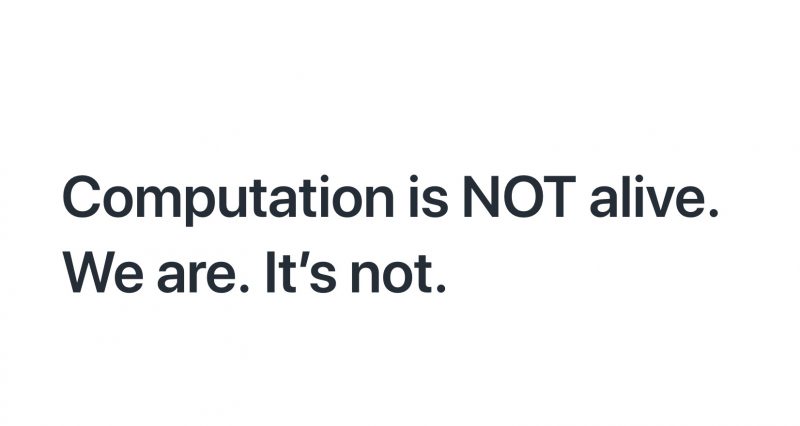This How To Speak Machine introduction is a bit frenetic and was rejected in the end.
In the spring of 2019, as I was putting the final touches on this book, I granted an interview to a business magazine to share what I might be writing about. They ran it and quoted me in the headline saying “design is not that important” alongside a photograph of myself while speaking. Immediately after the interview went live, I was dragged through the mud online not just because designers felt their profession was insulted but because they felt insulted by one of their own by having spoken those five words. While this was all happening, on the one hand I marveled at the effectiveness of the headline crafted by simply omitting my punchline of “… as the impact of computation” which would have led to less controversy and vitriol. On the other hand, I could imagine how if I had skipped reading the interview and just read the shocker headline that I’d be on the side of the mob wishing to make me excommunicado from the hallowed Temple of Design.
You see, for most of my career I’ve been fortunate to be a member of what I term the “Temple of Design” — which can sound a bit like a religion because of its army of true believers who operate largely on faith. I’m one of those many practicing believers of its many traditions and values having been formally educated in a Bauhaus-style graduate art program, to designing for eponymous brands like Shiseido and Cartier, to by some miracle being represented in the permanent collection of the Museum of Modern Art, and to publishing eight books on design and making it the subject of a few TED talks. I guess what made this beautiful world feel especially like a religion for me was when every year during commencement season I wore the traditional velvet robes bearing the seals of the sixteenth president of the Rhode Island School of Design. There’s nothing like wearing a thick black robe in the heat of the summer sun with a heavy pendant impregnated with a shard of the Parthenon dangling around your neck to question whether you’re running a university or a church instead.
But with each new graduate whose hand I would firmly grasp with the right hand while handing them a diploma with the left hand, I found my faith in the Temple of Design tested. With each confirming handshake that sent a new designer off to their exciting future, I felt my honed beliefs erode and wane when considering how the world they were to enter was nothing like the world in which design education was originally conceived. Granted, there’s been a great deal of progress in how design is taught across the world and for most of the latter half of the twentieth century it could keep pace — but since the turn of the century something has happened that renders the past exponentially less relevant. The late artist David Bowie presciently called it in 1999 when his BBC interviewer dismissively comment about the Internet, to which he invited a contrary interpretation: “It’s an alien life form, … and it’s just landed here.” Since the landing of this alien life form, the world has not been the same — and design as its conventionally been defined by the Temple of Design no longer felt to me like the foundational language of our products world.
A new form of design has made itself known: computational design. It’s the kind of design that has less to do with the paper, cotton, ink, or steel that we use in all the experiences that we craft out of physical materials, and instead has more to do with bytes, pixels, voice, and AI that we use in all the experiences that we craft out of invisible materials powered by new computing technologies. It’s the text bubble that pops up on your screen with a message from your loved one, or it’s the perfect photo that you shot in the cold rain with your hands trembling and yet it came out perfectly, or it’s the friendly “Here you go, John” that you hear when you ask your smart stereo to play your favorite Bowie tunes. These new kind of interactions with our increasingly intelligent devices and surrounds require a fundamental understanding of how computing works to maximize what can get made.
This approach is consistent with the Temple of Design and is how all great products come to be — they’re built on a deep understanding of the materials being used and the customer to be served. Think of how a motorcycle designer needs to understand the physics of a combustion engine if they’re letting a rider wrap their legs around it at high speeds. Or, how a master chef needs to closely work with the supplier that foraged their vegetables or meats to exact the best flavors that meet the high expectations of their diners. The problem introduced with computational design is that its raw materials have never been native to the gardens or villas of the Temple of Design beyond a few token “computer labs” with limited usage hours in an unprecedented time when the giant tech companies are operating at the scale of millions of live users across all time zones tapped into a practically unlimited pool of computing power.
The computational world follows its own set of laws of design, and the world has become divided into those who understand it and those who don’t. I wrote this book to bridge the gap that is widening at an unnaturally rapid pace due to another religious force out there: the Temple of Tech. As a card-carrying member of the Temple of Design who felt their loyalties tested with my seeming proclamation that design is not that important as the impact of computation, I was reminded that I’m also a card-carrying member of the Temple of Tech — which was my first calling and religion forged in the revered “drinking from a firehose” traditions of MIT as an electrical engineering and computer science student. I also started to remember that I served as a professor at the MIT Media Laboratory where I led research at the intersection of computation and design for over a decade, and I have appeared to have come back to where I originally started.
Carrying two membership cards doesn’t reduce the pain of being hazed by colleagues from either club, but it does let you serve as a bridge between doctrines. And for anyone who serves a bridging role in society, you know firsthand that a bridge needs to be stepped on and tested before it can get reliably crossed. Having stood at the intersection of design and computation for now thirty years, I’m comfortable being uncomfortable already. So I intend to welcome the new discomfort of what is likely to continue for at least into the next decade of strangers nervously stepping up towards me to ask why I said that design didn’t matter, to whom I can respond: design is not as important as the impact of computation.
The rest of this introduction was accepted — it’s a little less spicy — but I’m glad to put this out there as I feel it captures some of the rawest feelings I’ve had about my journey thus far. —JM


